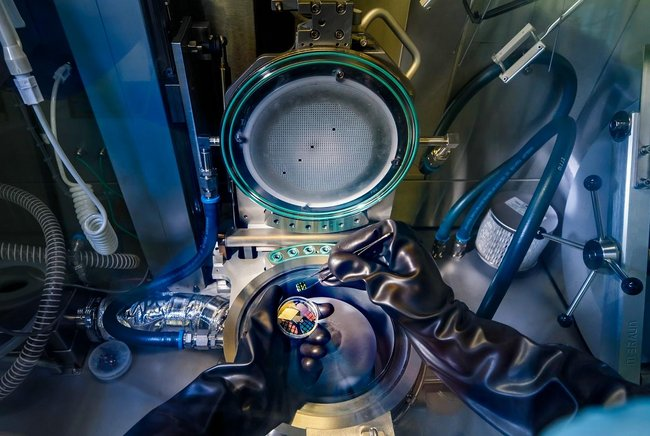Apr 9 2020
For many years, producing light from silicon has remained the “Holy Grail” of the microelectronics sector. But if this mystery is solved, it would redefine computing since chips will turn out to be faster than ever before.
 A look inside the Metal Organic Vapor Phase Epitaxy (MOVPE). This machine was used to grow the nanowires with hexagonal silicon-germanium shells. Image Credit: Nando Harmsen, TU/e.
A look inside the Metal Organic Vapor Phase Epitaxy (MOVPE). This machine was used to grow the nanowires with hexagonal silicon-germanium shells. Image Credit: Nando Harmsen, TU/e.
Scientists from Eindhoven University of Technology (TU/e) have successfully developed a silicon-based alloy that can produce light. The results of the study have been published in the Nature journal. The researchers will now begin to develop a silicon laser for integration into the existing chips.
People use and generate considerably more amount of data every year; however, the existing technology, which is based on electronic chips, is nearing its limit. Here, heat is the sole limiting factor, which arises from the resistance experienced by the electrons while they are moving via the copper lines that link the numerous transistors on a chip.
If people wish to continue to transfer an increasing amount of data every year, then they would require a new method that does not generate heat. This is where photonics comes in, which utilizes photons, or, light particles, to convey the data.
Unlike electrons, photons do not go through resistance. Since photons lack charge or mass, they do not scatter much inside a material in which they are traveling through and, as a result, heat is not generated. This, consequently, leads to reduced energy consumption.
In addition, when electrical communication inside a chip is replaced by optical communication, the rate of chip-to-chip and on-chip communication can be enhanced by a factor of 1000.
Faster data transfer and less energy consumption for cooling systems will significantly benefit data centers. In addition, these photonic chips will also lead to the development of novel applications, including laser-based radar for autonomous cars, chemical sensors for quantifying food and air quality or for medical diagnosis.
Dropping Electron Emits a Photon
People will require a light source to use light in chips, that is, an integrated laser. Silicon is the primary semiconductor material used for making computer chips. However, bulk silicon is highly inefficient when it comes to producing light, and hence was long believed to have no role in photonics.
Therefore, the researchers looked at more intricate semiconductors, like indium phosphide and gallium arsenide. While these semiconductors can efficiently produce light, they are rather costly when compared to silicon and cannot be easily incorporated into present-day silicon microchips.
Hence, to develop a silicon-compatible laser, the researchers had to create a form of silicon that is capable of producing light. This form of silicon was successfully produced by TU/e scientists.
Along with scientists from the universities of Jena, Munich, and Linz, the TU/e team integrated germanium and silicon in a hexagonal structure that is capable of producing light—a major breakthrough that was realized after five decades of work.
Hexagonal Structure
The crux is in the nature of the so-called band gap of a semiconductor. If an electron ‘drops’ from the conduction band to the valence band, a semiconductor emits a photon: light.
Erik Bakkers, Study Lead Researcher¸ Eindhoven University of Technology
But as is the case in silicon, photons will not be emitted if the valence band and conduction band are displaced with regard to one another, which is known as an indirect band gap.
“A 50-year old theory showed however that silicon, alloyed with germanium, shaped in a hexagonal structure does have a direct band gap, and therefore potentially could emit light,” added Bakkers.
But it is not easy to shape silicon in a hexagonal structure. Since Bakkers and his research team have aced the method of growing nanowires, they successfully created hexagonal silicon earlier in 2015.
The researchers created pure hexagonal silicon by initially growing nanowires that were developed from another material having a hexagonal crystal structure. They subsequently grew a shell made of germanium and silicon on this template.
We were able to do this such that the silicon atoms are built on the hexagonal template, and by this forced the silicon atoms to grow in the hexagonal structure.
Elham Fadaly, Study Co-First Author, Eindhoven University of Technology
Silicon Laser
However, the researchers were unable to make the silicon atoms to produce light, until now. By reducing the crystal defects and the number of impurities, Bakkers’ research team was able to boost the quality of the hexagonal silicon-germanium shells. Upon stimulating the nanowire with a laser, the researchers could quantify the efficiency of the novel material.
According to Alain Dijkstra, also the co-first author of the study and who was responsible for quantifying the light emission: “Our experiments showed that the material has the right structure, and that it is free of defects. It emits light very efficiently.”
Bakkers believes that developing a laser now is a matter of time.
By now we have realized optical properties which are almost comparable to indium phosphide and gallium arsenide, and the materials quality is steeply improving. If things run smoothly, we can create a silicon-based laser in 2020.
Erik Bakkers, Study Lead Researcher¸ Eindhoven University of Technology
Bakkers continued “This would enable a tight integration of optical functionality in the dominant electronics platform, which would break open prospects for on-chip optical communication and affordable chemical sensors based on spectroscopy.”
Meanwhile, Bakkers’ team is also looking for methods to incorporate the hexagonal silicon in cubic silicon microelectronics, which is a crucial prerequisite for this study.
The study was financially supported by the EU project SiLAS, managed by TU/e professor Jos Haverkort.